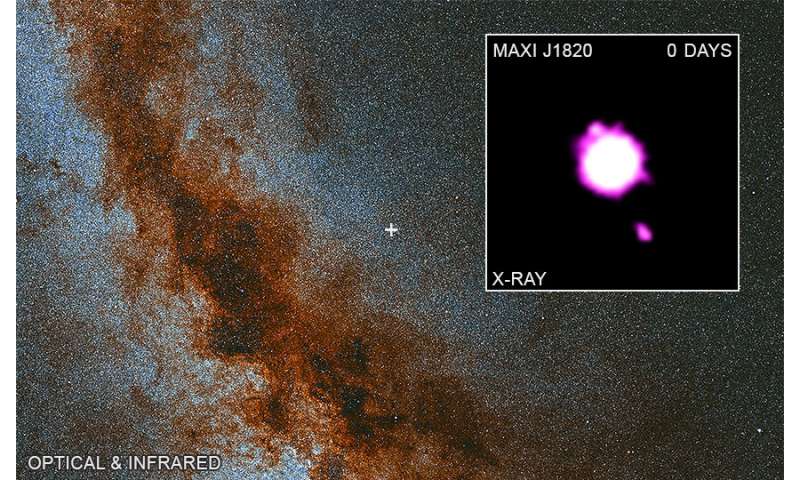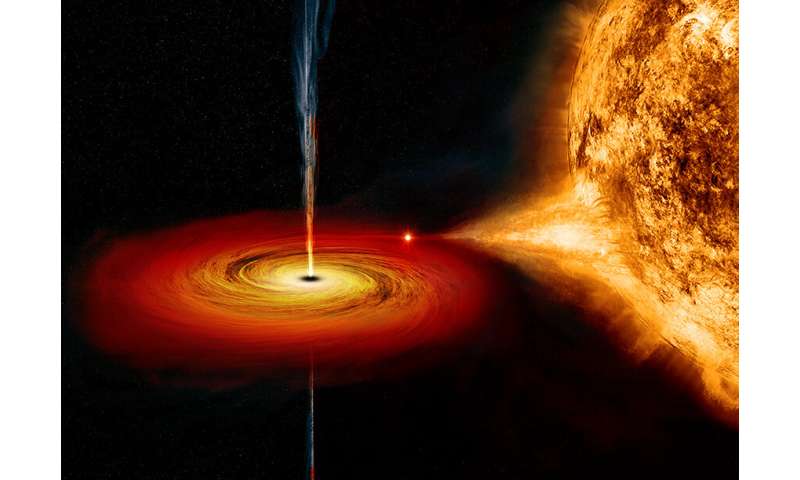MAXI J1820+070: Black hole outburst caught on video
by Science X staff
Astronomers have caught a black hole hurling hot material into space at close to the speed of light. This flare-up was captured in a new movie from NASA's Chandra X-ray Observatory.
The black hole and its companion star make up a system called MAXI J1820+070, located in our galaxy about 10,000 light years from Earth. The black hole in MAXI J1820+070 has a mass about eight times that of the sun, identifying it as a so-called stellar-mass black hole, formed by the destruction of a massive star. (This is in contrast to supermassive black holes that contain millions or billions of times the sun's mass.)
The companion star orbiting the black hole has about half the mass of the sun. The black hole's strong gravity pulls material away from the companion star into an X-ray emitting disk surrounding the black hole.
While some of the hot gas in the disk will cross the "event horizon" (the point of no return) and fall into the black hole, some of it is instead blasted away from the black hole in a pair of short beams of material, or jets. These jets are pointed in opposite directions, launched from outside the event horizon along magnetic field lines. The new footage of this black hole's behavior is based on four observations obtained with Chandra in November 2018 and February, May, and June of 2019, and reported in a paper led by Mathilde Espinasse of the Université de Paris.
The main panel of the graphic is a large optical and infrared image of the Milky Way galaxy from the PanSTARRS optical telescope in Hawaii, with the location of MAXI J1820+070 above the plane of the galaxy marked by a cross. The inset shows a movie that cycles through the four Chandra observations, where "day 0" corresponds to the first observation on November 13th, 2018, about four months after the jet's launch. MAXI J1820+070 is the bright X-ray source in the middle of the image and sources of X-rays can be seen moving away from the black hole in jets to the north and south. MAXI J1820+070 is a point source of X-rays, although it appears to be larger than a point source because it is much brighter than the jet sources. The southern jet is too faint to be detected in the May and June 2019 observations.
Just how fast are the jets of material moving away from the black hole? From Earth's perspective, it looks as if the northern jet is moving at 60% the speed of light, while the southern one is traveling at an impossible-sounding 160% of light speed!
This is an example of superluminal motion, a phenomenon that occurs when something travels towards us near the speed of light, along a direction close to our line of sight. This means the object travels almost as quickly towards us as the light it generates, giving the illusion that the jet's motion is more rapid than the speed of light. In the case of MAXI J1820+070, the southern jet is pointing towards us and the northern jet is pointing away from us, so the southern jet appears to be moving faster than the northern one. The actual velocity of the particles in both jets is greater than 80% of the speed of light.
Only two other examples of such high-speed expulsions have been seen in X-rays from stellar-mass black holes.

MAXI J1820+070 has also been observed at radio wavelengths by a team led by Joe Bright from the University of Oxford, who previously reported the detection of superluminal motion of compact sources based on radio data alone that extended from the launch of the jets on July 7, 2018 to the end of 2018.
Because the Chandra observations approximately doubled the length of time the jets were followed, a combined analysis of the radio data and the new Chandra data by Espinasse and her team gave more information about the jets. This included evidence that the jets are decelerating as they travel away from the black hole.
Most of the energy in the jets is not converted into radiation, but is instead released when particles in the jets interact with surrounding material. These interactions might be the cause of the jets' deceleration. When the jets collide with surrounding material in interstellar space, shock waves—akin to the sonic booms caused by supersonic aircraft—occur. This process generates particle energies that are higher than that of the Large Hadron Collider.
The researchers estimate that about 400 million billion pounds of material was blown away from the black hole in these two jets launched in July 2018. This amount of mass is comparable to what could be accumulated on the disk around the black hole in the space of a few hours, and is equivalent to about a thousand Halley's Comets or about 500 million times the mass of the Empire State Building.
Studies of MAXI J1820+070 and similar systems promise to teach us more about the jets produced by stellar-mass black holes and how they release their energy once their jets interact with their surroundings.
Radio observations conducted with the Karl G. Jansky Very Large Array and the MeerKAT array were also used to study MAXI J1820+070's jets.
A paper describing these results is published in the latest edition of The Astrophysical Journal Letters
More information: Relativistic X-ray jets from the black hole X-ray binary MAXI J1820+070: arXiv:2004.06416 [astro-ph.HE] arxiv.org/abs/2004.06416
Journal information: Astrophysical Journal Letters
Provided by Chandra X-ray Center